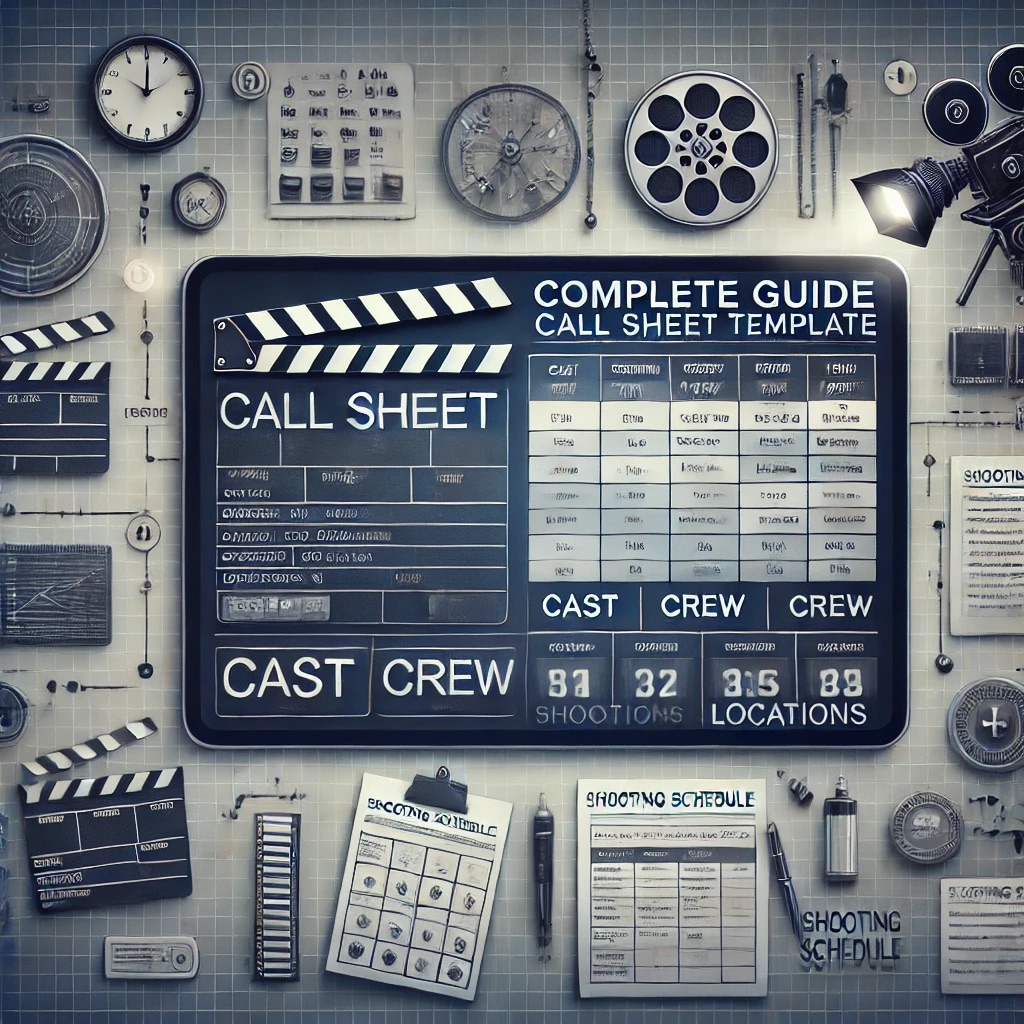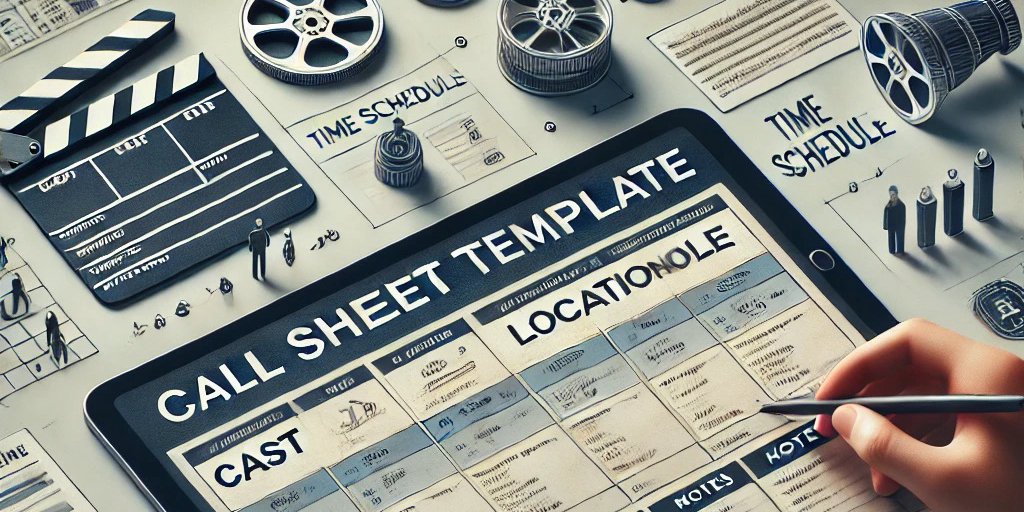In the world of film production, organization and efficiency are paramount. Every production, whether a movie, commercial, or photoshoot, requires careful planning to keep the cast and crew aligned. This is where call sheets come into play. Call sheets are essential tools for maintaining order and ensuring everyone knows their role, location, and schedule on a production day. This guide will delve into the components of a call sheet template, the advantages of using templates, and practical tips for creating effective call sheets to keep production on track.

What is a Movie Call Sheet?
A movie call sheet is a document distributed to the cast and crew, providing essential information for each day of shooting. It’s generally created by the First Assistant Director (1st AD) or the production team and includes details like the production title, crew call times, shooting schedule, weather forecast, and contact information.
Key Components of a Call Sheet:
-
Project Details: Title, location, and contact information.
-
Crew Call Times: Specific times each department needs to be on set.
-
Shooting Schedule: A detailed breakdown of scenes, locations, and setups.
-
Weather Forecast: Important for outdoor scenes.
-
Emergency Information: Nearby hospital, emergency contacts.
A well-crafted call sheet is vital for keeping everyone informed, punctual, and prepared for the day’s events.
Why Use Call Sheet Templates?
Using a call sheet template can save time, improve accuracy, and reduce miscommunication. Here’s why call sheet templates are a must-have in production management:
-
Improved Organization: Templates streamline the process, ensuring that no essential details are missed.
-
Clear Communication: With all contact information and schedules in one place, crew members have everything they need to stay on track.
-
Time Efficiency: Templates make it easy to update details quickly without starting from scratch each day.
-
Professionalism: A well-organized call sheet reflects professionalism and attention to detail, contributing to a smooth production flow.
With a template, you can avoid the hassle of building a call sheet from scratch and focus more on the intricacies of the production itself.
Main Components of a Call Sheet Template
A standard call sheet template is divided into sections, each dedicated to specific information that helps the crew stay coordinated. Let’s go over the primary components:
Contact Details
Every call sheet should include the contact information for key personnel, such as the producer, director, and assistant director. This makes it easy for crew members to reach anyone quickly in case of questions or issues.
Production Name & Crew Call
The production name and general crew call time are typically displayed at the top of the call sheet. This ensures clarity on the project name and the overall time that the entire crew is expected on set.
Schedule, Weather, & Locations
This section details the day’s shooting schedule, including scene numbers, descriptions, locations, and call times for specific scenes. The weather forecast is crucial, particularly for outdoor shoots, as it affects set preparations and logistics. Additionally, list addresses for each location to guide cast and crew members accurately.
Crew and Cast Lists
The crew list organizes personnel by department, including contact details and specific call times. The cast list provides details such as character names, actor names, and individual call times to streamline organization.
Having a clear crew and cast list helps to minimize delays, avoid confusion, and keep the day’s schedule on track.
Best Practices for Creating Call Sheets
Creating an effective call sheet requires more than just filling out a template. Here are some best practices to ensure accuracy and clarity:
-
Daily Folders for Call Sheets: Organize your call sheets in daily folders to simplify tracking and ensure easy access to past call sheets.
-
Back Up Files: Always back up call sheets, either on cloud storage or an external drive, to prevent data loss.
-
Send PDFs: Send call sheets in PDF format to maintain formatting consistency and prevent edits.
-
Proofread: A quick review can prevent critical mistakes, especially in contact details, times, and locations.
-
Seek Approval: Get approval from department heads before finalizing to confirm that all information is correct and relevant.
By adhering to these best practices, you can create call sheets that are both reliable and professional, fostering a smoother production experience for everyone involved.
Free Call Sheet Templates for Word and Excel
For those who want to save time, free call sheet templates are available, covering various production types from feature films to photoshoots. Here are some examples:
1. Simple Call Sheet Template
This basic template includes key details like crew call time, weather forecast, and scene list, making it suitable for smaller projects with straightforward needs.
Ideal for: Short films, student projects, and small-budget productions.
2. Detailed Call Sheet Template
The detailed template provides space for additional information, such as cast makeup times, lunch breaks, and special notes for each department. It is ideal for complex productions requiring more extensive coordination.
Ideal for: Feature films, TV shows, and commercials.
3. Photoshoot Call Sheet Template
Specifically designed for photoshoots, this template includes fields for model call times, wardrobe details, and specific location needs, making it perfect for photography-based projects.
Ideal for: Magazine shoots, editorial spreads, and fashion shows.
4. Commercial Call Sheet Template
This template is tailored for commercials, including fields for client representatives, specific product details, and tight timelines. It’s ideal for projects that require coordination with agency representatives and stakeholders.
Ideal for: Advertising campaigns, commercial shoots, and branded content.
Using these templates can greatly reduce preparation time and help maintain consistency in communication across the crew.
Conclusion
A well-prepared call sheet is the backbone of any successful production. From organizing schedules and call times to providing key contact information, a call sheet template ensures everyone on set has what they need to perform their role efficiently. With the right template and attention to detail, creating call sheets becomes a seamless part of the production workflow.
Whether working on a film, commercial, or photoshoot, implementing structured call sheets supports smoother communication, minimizes delays, and contributes to the success of the production. Start with a free call sheet template, tailor it to your needs, and experience the positive impact of effective call sheet management on your next project.
Source: How to Make the Best Call Sheet Template For Your Production
Read also our last article: Optimize Change Requests: Free Templates and Best Practices
